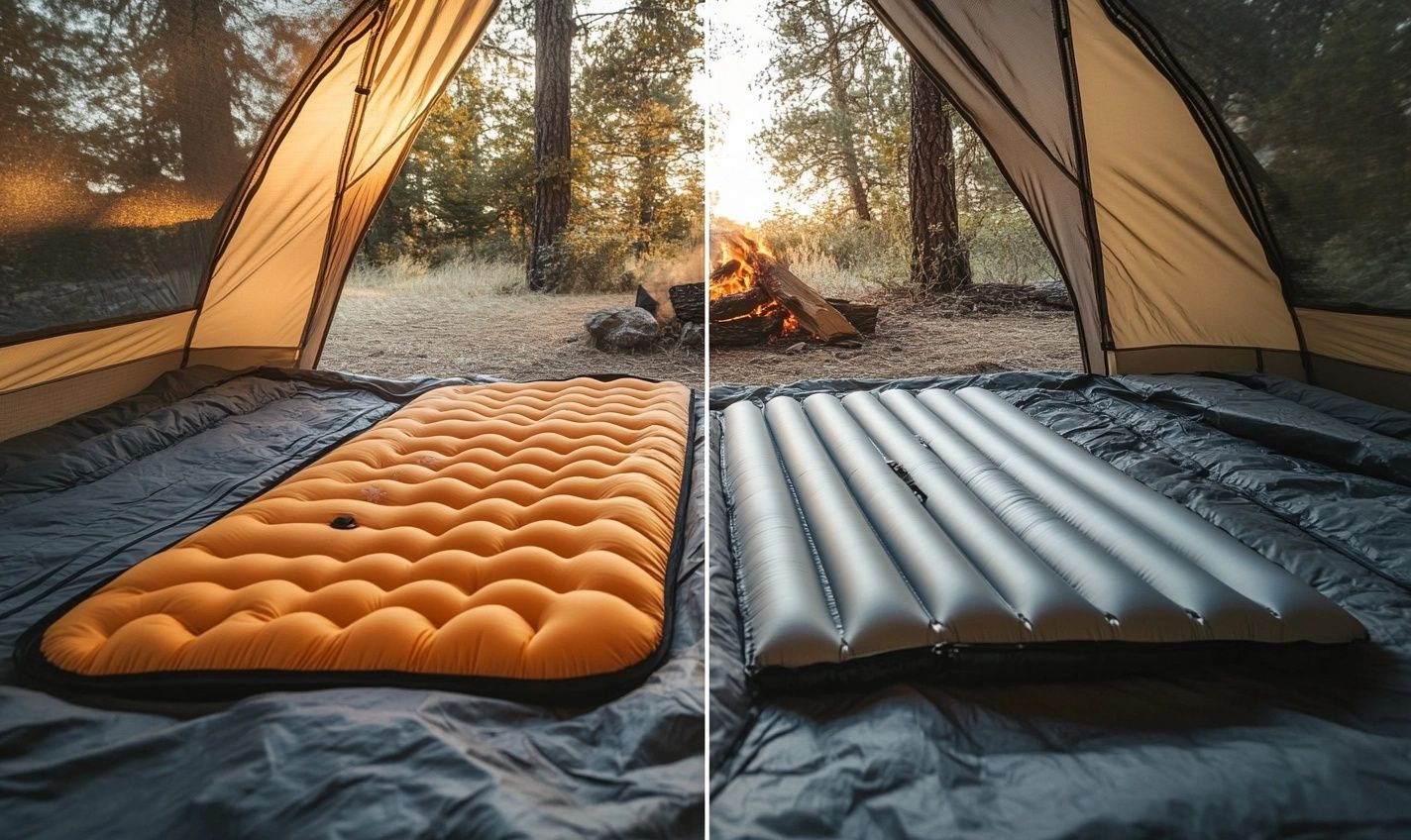Table Of Content
- Understanding Sleeping Pads
- Inflatable Sleeping Pads – Pros and Cons
- Foam Sleeping Pads: Pros and Cons
- Weight and Packability Comparison
- Warmth and Insulation
- Inflatable Sleeping Pads: Pros and Cons
- Pros of Inflatable Sleeping Pads
- Cons of Inflatable Sleeping Pads
- Foam Sleeping Pads: Pros and Cons
- Pros of Foam Sleeping Pads
- Cons of Foam Sleeping Pads
- Weight and Packability Comparison
- Inflatable Sleeping Pads
- Foam Sleeping Pads
- Choosing the Right Sleeping Pad: Understanding Warmth and Insulation
- Inflatable Sleeping Pads
- Foam Sleeping Pads
- Comparing Warmth and Insulation
- Enhancing Your Camping Experience
- Comfort and Support
- Inflatable Sleeping Pads
- Foam Sleeping Pads
- Durability and Longevity
- Material Quality
- Construction Design
- Resilience to Elements
- Maintenance Requirements
- Noise and Maintenance
- The Hiss Factor: Noise Level of Inflatable Sleeping Pads
- Easy Care: Maintenance of Foam Sleeping Pads
- Frequently Asked Questions (FAQs)
Regarding camping gear and equipment, a reliable sleeping pad is essential for a comfortable night’s sleep in the great outdoors. As an experienced camper and outdoor enthusiast, I understand the importance of choosing the right sleeping pad to ensure a restful night under the stars.
In this comprehensive guide, we will delve into the world of inflatable and foam sleeping pads, comparing the two to help you determine which option best suits your camping needs. Both inflatable and foam sleeping pads have pros and cons, making it crucial to consider various factors such as comfort, durability, and portability.
While inflatable sleeping pads offer superior comfort and insulation, they can be bulky and prone to punctures. Foam sleeping pads are lightweight and durable but may not provide the same comfort level as inflatable pads. Understanding the distinctions between these two types of camping pads can help you make an informed decision about your next outdoor adventure.
Join me as we explore the world of camping pads and discover the pros and cons of inflatable and foam sleeping pads. Whether you’re a seasoned camper or new to the world of outdoor sleeping gear, this guide will equip you with the knowledge needed to choose for a good night’s sleep in the wilderness.

Understanding Sleeping Pads
One essential item in camping gear that is often overlooked is the sleeping pad. Like a cozy blanket on a cold night, a good sleeping pad can make all the difference in your outdoor sleeping experience. Let’s explore the world of sleeping pads and understand their significance.
Inflatable Sleeping Pads – Pros and Cons
Inflatable sleeping pads are like air mattresses in the camping world. They are lightweight and compact and offer excellent comfort. However, they can be prone to punctures and may take some effort to inflate.
Foam Sleeping Pads: Pros and Cons
On the other hand, foam sleeping pads are like the sturdy workhorses of camping gear. They provide reliable insulation, are durable, and are hassle-free to set up. Yet, they may be bulkier and less comfortable than inflatable pads.
Weight and Packability Comparison
Weight and packability are crucial factors to consider when choosing a sleeping pad. Inflatable pads are typically lighter and more compact, making them ideal for backpacking trips. However, heavier and bulkier foam pads are great for car camping, where weight is less of a concern.
Inflatable Sleeping Pads:
– Lightweight
– Compact
– Ideal for backpacking
Foam Sleeping Pads:
– Durable
– Insulating
– Preferable for car camping
Warmth and Insulation
Both types of sleeping pads offer varying degrees of warmth and insulation. Inflatable pads usually have higher R-values, making them better suited for cold-weather camping. Foam pads provide decent insulation but may be less effective in extreme conditions.
And that wraps up our brief guide to understanding sleeping pads. Remember, the right sleeping pad can elevate your camping experience, providing a comfortable and restful night under the stars. So, choose wisely and sleep soundly on your next outdoor adventure!

Inflatable Sleeping Pads: Pros and Cons
If you’re in the market for a new camping pad, you may consider inflatable sleeping pads. These pads, filled with air and usually made of lightweight materials, have advantages and disadvantages. Let’s examine the pros and cons of using an inflatable sleeping pad for your next outdoor adventure.
Pros of Inflatable Sleeping Pads:
- High Level of Comfort: Inflatable pads offer excellent cushioning and support, mimicking the feel of a natural mattress.
- Compact and Lightweight: When deflated, these pads pack down small, making them easy to transport and ideal for backpacking.
- Adjustable Firmness: You can easily customize the firmness of an inflatable pad by adding or releasing air, catering to your desired level of comfort.
Cons of Inflatable Sleeping Pads:
- Potential Puncture Risks: Unlike foam pads, inflatable pads are susceptible to punctures from sharp objects outdoors.
- Inflation Challenges: Blowing up an inflatable pad can be time-consuming and requires lung power, especially after a long day of hiking.
- Thermal Conductivity: Inflatable pads may not offer the same level of insulation as foam pads, leading to colder nights in chillier conditions.
When choosing the right sleeping pad for camping, consider the trade-offs between inflatable and foam pads. While inflatable pads offer superior comfort and portability, they come with the risk of potential punctures and may not provide the same insulation as foam pads.

Foam Sleeping Pads: Pros and Cons
Regarding camping gear and equipment, your sleeping pad can make all the difference between a restful night under the stars and a sore back in the morning. Foam sleeping pads are popular among campers for their reliability and comfort. Let’s explore the pros and cons of using foam sleeping pads during your outdoor adventures.
Pros of Foam Sleeping Pads:
- Comfort: Foam sleeping pads are known for their excellent cushioning, providing a cozy and supportive surface for a good night’s sleep.
- Durability: These pads are incredibly durable and can withstand rough terrains, making them a long-lasting investment for frequent campers.
- Insulation: Foam pads offer excellent insulation, keeping you warm during chilly nights by preventing the cold ground from sapping your body heat.
Cons of Foam Sleeping Pads:
- Weight and Packability: Foam pads are bulkier and heavier than inflatable sleeping pads, making them less ideal for backpackers looking to save on weight and space.
- Portability: Their size makes it challenging to carry foam sleeping pads on longer treks or hikes, especially if you’re aiming for a lightweight setup.
- Comfort Level: While foam pads offer decent comfort, some campers may find them less cushioned than inflatable options, compromising plushness.
Ultimately, the choice between foam and inflatable sleeping pads comes down to personal preference and the type of camping you enjoy. If you prioritize durability, insulation, and a reliable sleep surface, foam sleeping pads might be perfect for outdoor adventures. However, if you prioritize lightweight and packable gear for long hikes or backpacking trips, you may want to consider the more compact inflatable sleeping pads.

Weight and Packability Comparison
Weight and packability are crucial when choosing the perfect sleeping pad for your camping adventures. Let’s compare inflatable and foam sleeping pads based on these factors to help you make an informed decision.
Inflatable Sleeping Pads:
- Pros:
- Lightweight: Ideal for backpackers looking to save weight.
- Packable: Easily deflates and rolls up compactly.
- Cons:
- Puncture Risk: Requires extra caution to prevent leaks.
- Inflation Time: It takes time and effort to inflate manually.
Foam Sleeping Pads:
- Pros:
- Lightweight: Provides consistent support without the need for inflation.
- Durable: Resistant to punctures and tears.
- Cons:
- Bulkier: Less compact when rolled up for transport.
- Less Insulation: Can be less insulating than inflatable pads.
Ultimately, comparing the weight and packability of inflatable and foam sleeping pads boils down to personal preference and priorities. Inflatable pads offer a lightweight and easily packable option for those willing to take extra care, while foam pads provide durability and reliability at the cost of some bulk.

Choosing the Right Sleeping Pad: Understanding Warmth and Insulation
Regarding camping gear, one of the most crucial aspects is the warmth and insulation your sleeping pad provides. A quality sleeping pad can distinguish between a restful night’s sleep and a chilly, uncomfortable experience in the great outdoors.
Inflatable Sleeping Pads:
Inflatable sleeping pads are famous for their lightweight design and superior comfort. They also provide excellent insulation from the cold ground, making them ideal for cold-weather camping. However, they can be prone to punctures and may require more maintenance than foam pads.
Foam Sleeping Pads:
Foam sleeping pads are durable and low-maintenance, making them a reliable choice for many campers. While they may not offer the same comfort level as inflatable pads, they provide excellent insulation and are less likely to deflate at night.
Comparing Warmth and Insulation:
Here’s a quick breakdown of the pros and cons of inflatable and foam sleeping pads when it comes to warmth and insulation:
- Inflatable Sleeping Pads:
- Pros: Lightweight, excellent insulation
- Cons: Prone to punctures, may require more maintenance
- Foam Sleeping Pads:
- Pros: Durable, low-maintenance, good insulation
- Cons: Less comfort compared to inflatable pads
Enhancing Your Camping Experience:
Choosing the right sleeping pad with adequate warmth and insulation is essential for a comfortable night under the stars. Consider the climate and terrain of your camping destination when selecting between inflatable and foam sleeping pads to ensure a restful night’s sleep.

Comfort and Support
Regarding camping gear, a good night’s sleep is essential for a successful outdoor adventure. One critical factor determining your sleeping comfort is the type of sleeping pad you choose. Let’s examine how inflatable and foam sleeping pads compare regarding comfort and support.
Inflatable Sleeping Pads:
- Offer excellent cushioning and support, mimicking the feel of a traditional mattress.
- Adjustable firmness allows you to customize your sleeping surface according to your preferences.
- Provide insulation from the cold ground, enhancing comfort during chilly nights.
Foam Sleeping Pads:
- Provide consistent support throughout the night without the risk of deflating.
- Simple and fuss-free setup – roll out, and you’re ready to sleep.
- Great for hikers and backpackers due to their lightweight and durable nature.
Inflatable sleeping pads often provide comfort with their customizable firmness and cushioning properties. However, foam sleeping pads shine in their simplicity and reliability, offering consistent support without inflation.
But ultimately, the choice between the two comes down to personal preference and the specific needs of your camping trip. Are you looking for a plush, mattress-like feel, or do you prioritize ease of use and durability?
Before making a decision, consider factors such as the terrain you’ll be camping on, the level of insulation needed, and your comfort preferences. A good night’s sleep is crucial for enjoying your outdoor adventures, so choose wisely regarding your camping pad.

Durability and Longevity
Regarding camping gear and equipment, the durability and longevity of your sleeping pad are crucial. You want a sleeping pad that can withstand the wear and tear of outdoor adventures while providing a comfortable night’s sleep for years to come. Let’s dive into the factors contributing to camping pads’ durability and longevity.
Material Quality
Inflatable Sleeping Pads: Made from rugged nylon and durable PVC, inflatable pads resist punctures and abrasions, ensuring longevity.
Foam Sleeping Pads: Closed-cell foam pads are known for their robust construction, which makes them less susceptible to damage from rough terrain.
Construction Design
Inflatable Sleeping Pads: The intricate construction of chambers and baffles provides structural integrity, prevents air leaks, and extends the pad’s lifespan.
Foam Sleeping Pads: Solid foam construction offers a sturdy and reliable sleeping surface that can last through many camping trips.
Resilience to Elements
Inflatable Sleeping Pads: While susceptible to punctures, most modern inflatable pads have repair kits for quick fixes, increasing longevity.
Foam Sleeping Pads: Waterproof and resistant to mold and mildew, foam pads are designed to withstand various weather conditions, enhancing their durability.
Maintenance Requirements
Inflatable Sleeping Pads: Regular maintenance, such as proper inflation and storage, is essential to ensure the longevity of inflatable pads.
Foam Sleeping Pads: Easy to clean and maintain, foam pads require minimal upkeep, contributing to their long-lasting performance.
In the grand camping pad comparison, both inflatable and foam sleeping pads offer unique benefits in terms of durability and longevity. While inflatable pads may require more care, they provide excellent comfort and support. On the other hand, foam pads are robust and low-maintenance, so they are ideal for rugged outdoor use.
Investing in a high-quality sleeping pad that matches your camping style and preferences is critical to enjoying many nights under the stars. Choose wisely; your camping pad will be your trusty companion for numerous future adventures.

Noise and Maintenance
When choosing the right camping pad, noise and maintenance are often overlooked aspects that can significantly improve your camping experience.
The Hiss Factor: Noise Level of Inflatable Sleeping Pads
Inflatable sleeping pads are notorious for their crinkly noises, which can disrupt a peaceful slumber. Consider the noise level when selecting your sleeping pad.
Easy Care: Maintenance of Foam Sleeping Pads
Foam sleeping pads are low-maintenance and require minimal care compared to inflatable ones. Roll them up, and they’re ready for your next adventure.
When choosing between inflatable and foam sleeping pads, it’s crucial to consider how noise and maintenance might impact your camping trip. Are you a light sleeper easily disturbed by rustling sounds, or do you prioritize convenience and easy upkeep?
Consider how much time and effort you will invest in maintaining your camping gear. Whether you opt for an inflatable sleeping pad that makes a bit of noise or a foam pad that requires effortless maintenance, finding the right balance for your needs is critical.
Conclusion
After exploring the differences between inflatable and foam sleeping pads, it is evident that both options have advantages and disadvantages. Inflatable sleeping pads offer superior comfort and insulation, making them popular among campers seeking a good night’s sleep. On the other hand, foam sleeping pads are more durable and easier to set up, making them a reliable choice for rugged outdoor adventures.
When considering which type of sleeping pad to invest in, it ultimately comes down to personal preference and intended use. If you prioritize comfort and don’t mind the extra effort of inflation, an inflatable sleeping pad may be your best option. However, if durability and hassle-free setup are your top priorities, a foam sleeping pad might be the better choice.
Regardless of your decision, having a quality sleeping pad is essential for a successful and comfortable camping trip. Both inflatable and foam sleeping pads provide insulation from the cold ground and cushion for a restful night’s sleep under the stars. So, carefully weigh the pros and cons, and choose the sleeping pad that best suits your needs and camping style.
Whether you’re a weekend warrior or a seasoned backpacker, investing in a high-quality sleeping pad is a worthwhile decision that will enhance your outdoor experience and ensure you wake up refreshed and ready to tackle the day’s adventures.
Frequently Asked Questions (FAQs)
What are the differences between inflatable sleeping pads and foam sleeping pads?
Inflatable sleeping pads are typically lighter and more compact for backpacking, while foam sleeping pads offer more insulation and durability but are bulkier to pack.
Which is more comfortable, inflatable sleeping pads or foam sleeping pads?
Inflatable sleeping pads are often considered more comfortable as they can be adjusted for firmness, while foam sleeping pads provide a more stable and consistent sleeping surface.
Are inflatable sleeping pads more expensive than foam sleeping pads?
Inflatable sleeping pads are pricier than foam ones due to their lightweight materials and design.
Can inflatable sleeping pads be punctured easily?
While inflatable sleeping pads can be punctured, most come with repair kits for quick fixes in the field.
Do foam sleeping pads provide enough insulation for cold-weather camping?
Foam sleeping pads offer excellent insulation and are preferred for cold-weather camping because they prevent heat loss through the ground.
Which type of sleeping pad is easier to set up, inflatable or foam?
Inflatable sleeping pads require inflation, which can be done manually or with a pump, while foam sleeping pads are ready to use without any setup.













No Comment! Be the first one.